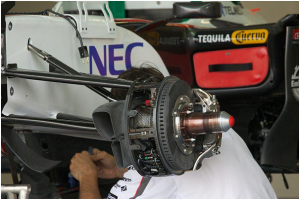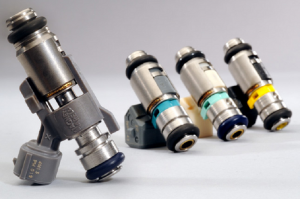The brakes used in Formula 1 cars need to be superb to cope with the challenges of racing. However, the brakes are actually very similar to regular car brakes. Formula 1 cars use disc brakes with rotating discs which are squeezed between brake pads using a hydraulic caliper. But they have some special qualities that enable them to cope with the racing circuit.

ABS Anti-Skid Technology Ban
If too much braking power is applied, the brakes can lock as the power is greater than the ability of the tyres to grip the road. This is where the anti-locking ABS braking technology helps slow a car safely and prevent locking.
ABS anti-skid systems were banned in Formula 1 in the 1990s, though they are popular safety features in regular cars. Due to the ban, F1 car drivers need to use great skill to brake without locking the system. However, there are some other helpful technologies.
Twin-Hydraulic Braking System
Each F1 car is required to have a hydraulic braking system that has two circuits. There are different reservoirs for the back and front wheels. This means a driver can still break even if one system locks down. In 2014, F1 cars were allowed to use electronic rear brake systems, which give better balance and stability. It is also important for F1 to have a Vehicle Tracking system within their cars which can be found at https://www.vehicle-accessories.net/vehicle-tracking, so they can keep logged numbers of where the vehicles are at all times and any stats that are needed.

A racing driver can control the braking power to each circuit manually, which helps to stabilize the handling. This control is exciting to see close up from the vantage point of a luxury viewing platform. It is easy for race fans to reserve such a viewing experience.
Turning Heat Energy to Electrical Energy
The main area where F1 car brakes are more sophisticated than road cars is in the materials used. The brake discs are made from carbon fibre, which can work at higher temperatures than the steel discs found in ordinary cars. The cars have to have an excellent cooling mechanism to cope with the high temperatures that the brake discs operate under.
F1 car brakes are highly efficient with short braking distances. Another innovation is that the energy created from braking is not all lost as heat, with much conserved and returned to the car as electrical energy through the Energy Recovery System (ERS).






